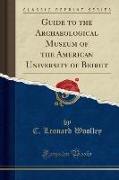- Start
- Guide to the Archaeological Museum of the American University of Beirut (Classic Reprint)
Guide to the Archaeological Museum of the American University of Beirut (Classic Reprint)
Angebote / Angebote:
Excerpt from Guide to the Archaeological Museum of the American University of Beirut
The nucleus of the Museum was formed by the gift, in 1868, by General P. A. Cesnola, of a typical series of pottery from his excavations in the island of Cyprus. In 1907 the Merrill collection, consisting for the most part of Palestinian pottery bought by Mr. Merrill when American Consul in Jerusalem, was secured by purchase, and in 1905 there was added the collection of M. Rouvier, which was of a more general character and included objects from Palestine, Beirut, Cyprus, Egypt and Greece. Large numbers ofob jects have been bought locally, from time to time, sometimes singly, sometimes in groups, which possess greater interest in that they are of Phoenician provenance: the most im portant ofthese are the large group of vases from the Bika' (case I 8 a group (not all of the same date) from Muhin, a tomb - group from Gharit'ah, and a series of Palestinian and trans-jordanian ¿int and bronze implements. In and after 1904 the Museum secured its excellent series of Palmyrene limestone busts. A few donations have been made by indi viduals, e. G. Of classical sculpture by Dr. H. H. Jessup, of inscriptions by the late Mr. Murad Baroody, of pottery and minor objects by M r. Frederick Bliss, but the Uni versity might justly expect from the ¿/zmmz' a more tan gible proof of their interest in their nation's history and of their private gratitude to the institution in the shape ofgifts to its Museum.
The arrangement of the collections is intended to illus trate as far as is possible the progress of civilization in South ern Syria, i. E. In Phoenicia and Palestine, and to assist the historical student whose interest in archeeology is butsecondary. Objects are classified by their date and by their country oforigin. Each wall - case represents a period Whose \limits are marked by the label above it: the objects in the case either come from one area, also clearly described, or from distinct areas, in which case they are arranged on dif ferent shelves labelled accordingly, where the exact hnd Spot of an object is known and is ofinterest an individual label is attached to the object. The cases go in historical order from 1 to 42, starting on the right of the entrance and running all round the gallery with the exception ofannex A only where objects are put in desk-cases for the purpose of better exhibition is there any break in continuity requiring cross - reference from the side to the center of the room, but in the desk~cases also historical sequence is observed so far as is possible. Sculptures and inscriptions are placed as available space and the interests of exhibition allow.
About the Publisher
Forgotten Books publishes hundreds of thousands of rare and classic books. Find more at www.forgottenbooks.com
This book is a reproduction of an important historical work. Forgotten Books uses state-of-the-art technology to digitally reconstruct the work, preserving the original format whilst repairing imperfections present in the aged copy. In rare cases, an imperfection in the original, such as a blemish or missing page, may be replicated in our edition. We do, however, repair the vast majority of imperfections successfully, any imperfections that remain are intentionally left to preserve the state of such historical works.
Folgt in ca. 15 Arbeitstagen

